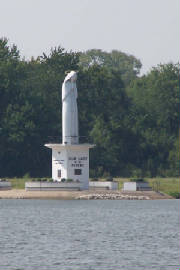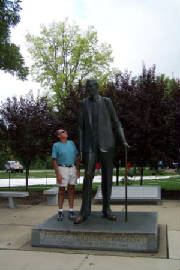September 13-15, 2005 Willow Island on the Illinois River to Alton, Illinois on the Mississippi
45.8 miles
We awoke to yet another beautiful morning with no chance of rain. We were up early enough to see the sunrise
tinting the wispy clouds pink and peach against the Wedgewood blue sky. Within minutes of leaving the anchorage
we saw a bald eagle high in a tree, his white head and tail nearly glowing in the warm early morning light.

|
| Our Lady of the River Shrine |
As we traveled down the river, we began to see bluffs rising behind broad expanses of riverbank floodplain.
We reached the spot where the Illinois River meets the Mississippi at 11:30. The waters of the Mississippi were wide,
with tall bluffs alongside.
A tall madonna at prayer marked the Our Lady of the River Shrine along the Missouri shore of the river.
The shrine was built by the grateful people of Portage des Sioux after the Great Flood of '51 stopped just short of
engulfing their town.
We tied up right next to the floating swimming pool and hot tub at the Alton Marina. We were tempted
to hop in after yet another day of unseasonably warm and sunny weather, but Alton was full of history, so we decided
to hop on our bikes to search out lunch and explore the town instead.
Alton was the site of the last Lincoln-Douglas Debate and the first United States martyr to freedom
of the press. It was home to the world's tallest human, and the smallest house designed by a prominent architect.
And it played a role in my family history.

|
| Alton Riverfront, dominated by the colorful Argosy Casino |
My dad's grandfather, who was a glass blower, rode his bicycle all the way from Rochester, New York
to Alton to get a job building a glass furnace. After he got established, he sent for his wife to join him with my grandmother
and her three sisters. I'm not sure if he worked for the Illinois Glass Company, but that was the big glass manufacturer
in town back then. Established in 1873, the company was known for inventing the glass ashtray. The company supplied
the ashtrays in bulk to hotels in New Orleans, which found it cheaper to have glass ashtrays lifted as souvenirs by guests
than to have their expensive brass trays removed from the premises.
As we explored Alton that afternoon and the next day, I imagine our bikes were rumbling over many
of the same hilly brick streets that my great grandfather used to ride.
Back in Ottawa, Illinois, we saw the site of the first Lincoln-Douglas debate, and here in Alton, we saw
the site of the seventh and final debate, marked by a sculptural representation of a tall lean Lincoln in a thoughtful pose,
and a short pudgy Douglas in a bombastic pose. Six thousand people showed up to listen. The Alton Daily Courier
showed a bit of bias in its coverage of the event. Here are a few excerpts:
About Douglas: " . . . his voice was completely shattered, and his articulation so very much impeded
that very few of the large crowd could understand an entire sentence . . . his own friends were disgusted with his pertinacity
and falsehood."
About Lincoln's response: ". . . he took up the oft-exploded charges of Douglas against the Republican
party and scattered them to the winds . . .so convincing was the array of testimony he produced, so clear and logical every
deduction made from them, and so honest and candid was he in all his assertions, that the Douglasites themselves were forced
to admit that they not only underrated the native strength of this man, but that he was greatly misrepresented in their papers.
. . .a complete vindication of himself and the Republican party, from the foul slander sought to be heaped upon them."
We rode up to the highest point in Alton, a cemetery where a huge granite column rising 93 feet holds
high a bronze statue of Victory, to honor the memory of Elijah P. Lovejoy. Lovejoy was an abolitionist newspaper editor
and church pastor who moved to Alton in 1836. He fought for freedom of the press, freedom of speech, and freedom from
slavery, despite repeated threats and attacks from citizens who did not share his views. Three of his printing presses
had been destroyed and thrown into the Mississippi before the historic night of November 7, 1837, when a group of supporters
joined him at a warehouse to guard a fourth press. A pro-slavery mob attacked the warehouse and tried to burn it.
As Lovejoy attempted to extinguish a blaze on the roof, a sniper killed him. The mob then destroyed the press and
threw it into the river.
The monument was dedicated on the sixtieth anniversary of Lovejoy's death. This historic episode was
new to us, and we were inspired by the story of the first American martyr to freedom of the press, and possibly the first
white person to die in our country's seemingly timeless battle for Civil Rights.

|
| Dick looks up to the Gentle Giant |
We found lots more interesting places of note. The tallest man in history, Robert Wadlow, was born,
grew up, and buried in Alton. He was 6' 2" at age 8, and 8' 11" by the time he died. A city park has a life-size
statue of Alton's "Gentle Giant" where you can stand to see how you measure up. On the small side, we saw a beautiful
little playhouse built for five-year-old Lucy Haskell. Her grandfather commissioned the area's most prominent architect
to design this little Queen Anne style treasure in 1885. Now it is on the National Register of Historic Places.
We have been following in the footsteps of Pere Marquette ever since we visited Mackinac Island, and
in Alton we once again found a reminder of Pere Marquette. In 1673 as Marquette and Joliet traveled down the Mississippi,
they saw the images of two large monsters painted on a bluff. Marquette described them in his diary thus: "each
was as large as a calf with horns like adeer, red eyes, a beard like a tiger's a face like a man, the body covered with green,
red, and black scales, and a tail so long that it passed around the legs, ending like a fishes' tail."
The Illini called the figure a Piasa, meaning a bird that devours men, and they had a legend of how a brave
chief with a vision from the Great Spirit used himself as bait for the bird, while twenty of his warriors laid in wait with
bows and poisoned arrows. When the Piasa attacked the chief, the Great Spirit protected him, and all his warriors'
arrows found their target in the Piasa. The Piasa died, the Illini engraved its image on the bluff to honor the event,
and no Illini passed the spot without discharging an arrow into the image of the Piasa forever after.
A recreation of the Piasa described by Pere Marquette is painted on a bluff just upriver of Alton.
We missed it from the water, but it is well-situated for viewing from the road.
After our very full day of exploring Alton, we expected to move on down the river, but we awoke to a thunderstorm
followed by persistent rain. We decided to stay another day. We mostly just hung out around the boat and relaxed,
but when the weather cleared up late in the afternoon, we walked to a fragrant little bakery recommended by all the locals,
where we stocked up. We hauled our treats back to the boat, and headed back out for dinner at Tony's, an Italian
restaurant where we had a great lunch the day before. We found not only excellent food, but one of the best dining bargains
of our trip -- a glass of wine, salad or soup, garlic bread plus a pasta dinner for $8.95. We ate our
fill and brought enough left-over lasagne and spaghetti and meatballs for another couple meals.
Click here to continue to page 2.
|

